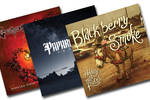Australia’s Obsession: Turning Nostalgia Into Innovation
Australia has been producing brilliant backward looking rock for generations, but now it’s showing the world how to do the impossible and make the old new.

The land down under snatched the zeitgeist in 2012, delivering the year’s most innovative hit single and spawning a neo-psychedelic guitar band who would put their Western peers to shame.
On the pop front they had Gotye’s strangely-strained-triumph “Someone That I Used To Know”, a clever and occasionally challenging hit that didn’t seek to patronize or overwhelm its audience with gaudy bombast. Not content to top the charts, Australia’s Tame Impala unleashed a stunning second album that redrew the parameters of retrospective-rock and psychedlia.
It was a pivotal moment, but to truly understand the importance of Lonerism by Tame Impala and the on rush of Aussie stars reimagining the history of guitar music, we have to first examine Australia’s unique place in rock history.
Mastering The Fundamentals
If Australia’s rock stars were sportsmen they’d be a coach’s dream (putting the sex, drugs and death to one side of course). After a slow genesis period, a slew of stars who eschewed innovation in order to master the fundamentals began to appear in the late-70s. Encapsulated by AC/DC, Aussie rock emphasized pounding riffs, technically adept soloing and irresistible melodic hooks. They perfected the building blocks of rock as the marriage of simplicity, precision and distinctly earthy, masculine swagger, proved irresistible.
It wasn’t always smooth sailing for the Australian rock scene. In keeping with the rest of the non-western world Australia was quick to catch onto both the rockabilly/surfs trends of the 50s and The Beatles led beat scene of the 60s. Despite the surge in interest in guitar music and a host of notable outfits emerging (The Easybeats, The Atlantics, etc.), Australian rock would have to wait until the mid-to-late 70s and 1980s for their impact to be felt on global level.

- INXS
By the mid-70s Australian rock clubs and bars were abuzz with sounds both local and international. It was a creeping inevitably that Australia would soon be ready to push back and use the tools of globalization to spread their vision of rock to foreign fields. Homegrown labels were established, surviving the shaky early years by hook or by crook, as global multinationals became imbedded in Australia with their eyes peeled for the next big thing, and television began programming consistently for the teen and young adult market with dedicated outlets for new music.
It was this fertile period that allowed a pub rock scene to emerge in Australia. A similar phenomenon occurred in the UK, but whereas that masculine scene had only a nominal impact on the progression of British music (it is considered a forerunner of punk in some dubious respects), in Australia it proved vital in two distinct ways. First, it established a wild, working class and straight ahead sense of what a rock star should be, and secondly these hugely popular but tightly packed gigs put an emphasis on rigid rhythms and metronomic riffs.
Sound familiar? The Scottish/Australian juggernaut AC/DC not only perfectly embodied these principles, they took the sound to it’s logical conclusion. They injected the terse power of Heavy Metal, the showmanship of pop, and a dose of technical virtuosity and rockabilly soloing into the firm but addictive strictures of pub rock. Crossover success was assured, but it wasn’t just hard rockers getting in on the act. The softer but equally classic sound of Little River Band would go 4xPlatinum in the US over the course of the next 20 years.
Throughout this period it is important to remember that Aussie rock moved with the times (and occasionally led the way). INXS and Men At Work were at the forefront of the 80s blending the rigid tricks of Aussie rock with the slick futuristic sounds of synth-pop and new wave. Nick Cave on the other hand, was on another planet, inspiring the alternative artists the world over with his anguish and sermonistic verses. There was always room for innovation but Australia never lost its retro-rock, working class, muscularity, as Jimmy Barnes reminded the world with his 80s hit “Working Class Man”.
Fast Forward To The Past
The 80s and 90s successfully established Australian acts in the charts of Western Europe and North America, but by the 2000s the nation’s obsession with retrospection had re-emerged. What was once the product of an organic evolution from the pub to the top of pops now became a studied exercise in recreating rock, grunge or indie history.
It might sound like a criticism to label these Aussie stars arch imitators, but make no mistake this generation consisted of astute scholars who created unrelenting anthems in their own right. As The Strokes and The Libertines were busy saving indie rock from the Travis and Coldplay inspired doldrums in the US and UK, the Aussies were quick to offer their own (harder rocking) alternative to mope pop. The Vines arrived fully formed blending the kind of garage rock The Strokes specialized in with loving flourishes that recalled Nirvana, Mudhoney, Silverchair and the Grunge greats.
Guitar Planet would never confuse a New Zealand band with an Aussie group, but the neighbouring island was quick to get in on the revisionist act. The Datsuns were less polished than The Vines, but they had the British and American press salivating when they dropped the stunning singles “Harmonic Generator” and “MF From Hell”. Despite the strength of their singles, neither The Vines nor The Datsuns could replicate the indelible impact of The Strokes and The Libertines. They had the precision and learned wildness, but not the idiosyncracies and the charisma that allows transcendent acts to break from the pack and shape the popular culture.
During the decade three further bands crystalized the image of Australia as the home of hard partying nostalgic rock. Jet were the first and most successful. Recalling both the 60s and 70s their sound was vintage from head-to-toe but relatively broadly drawn touching on everyone from Oasis and The Sweet to AC/DC and The Verve. Wolfmother on the other hand, offered a bruising take on classic rock and proto-metal with their Led Zeppelin aping assault and festival thrilling anthems “Woman” and “Joker And The Thief”. Airbourne completed the nostalgic trio. The masters of throw-away-party-rock they brought demonic energy and enthusiasm but have yet to muster an original thought.
So How Do You Make The Old New?
It’s the question that has plagued Australia’s crossover stars ever since the dawn of the 1990s. How did AC/DC make primitivism sound so fresh and revolutionary? Could anyone ever hope to repeat the trick and allow the land down under to rise to the top and lead the way once again?

- Tame Impala
Progressive rock held the answer. Before 2012 prog-rock in Australia was the preserve of heavy acts like Dead Letter Circus and Karnivool (both of whom had their merits) but the scene was hardly revolutionary. In 2010 five musicians in Perth, Western Australia banded together and created an album named Innerspeaker. It was a critically acclaimed sensation, another slab of typically Australian nostalgia that was built of thick, fuzzed out and utterly all consuming riffs that recalled the sounds of the late 60s and 70s. (This all sounds awfully familiar, right?) It was dynamic and charming, but not a game changer.
When Tame Impala returned in 2012 the rock world expected more of the same. They were in for a shock. Their sophomore LP Lonerism blended state of the art electronic production with expert homages to the psychedelia of the 1970s. The result was, firstly, a stunning album chocked full of irresistible tracks, and secondly a record whose aquatic-come-fuzzy textures recalled the past but could not have possibly been made in any time but the present. Had Lonerism existed 40 years ago it would have blown minds and melted faces, familiar enough to understand, but utterly otherworldly.
Not content to innovate with just one band, bassist Cam Avery also worked with the NME endorsed Pond who offered a more playful, down-the-rabbit-hole take on modern psychedelia with contorted guitars and jabbering vocals. It seemed clear whatever Tame Impala touched, be it a daffy side project or a sultry French pop star, turned to gold.
For all their brilliance it’s hard to discern what exactly makes Tame Impala so modern. The past and future is intertwined so tightly in their music, the point at which one ends and the other begins becomes almost indistinguishable. This is why they are the perfect representatives of Australia’s 50+ year obsession with music’s past.
The Aussies have finally done the impossible made the old new and Tame Impala are already inspiring a new wave of psych-hopefuls (Jagwar Ma is the latest shiny young thing to take on the world). Do not miss Tame Impala at this summer’s festivals; it’s your chance to see the culmination of an entire nation’s musical evolution.
In The Magazine

Enter Shikari – The Mindsweep
Enter Shikari renew their archly political assault while expanding their sonic horizons on The Mindsweep.

The Guitarist Of The Year: 5. Mike Kerr
Brutish, brazen and ungodly satisfying, Royal Blood rode a barrage of chugging bass grooves all the way to the top of the charts in 2014.

The Guitarist Of The Year: 6. Mikael Akerfeldt/Fredrik Akesson
Opeth may preach exclusively to the converted, but to overlook the Swedes’ staggeringly consistent brilliance is foolhardy.

The Guitarist Of The Year: 7. Adam Granduciel
Soothing and sorrow-laden in equal measure, Lost In The Dream by The War On Drugs left Guitar Planet speechless.

The Guitarist Of The Year: 8. Slash
Guitar Planet has had a love/hate relationship with Slash since Velvet Revolver split, but it remains impossible to deny his freewheeling riffs and slippery solos.










